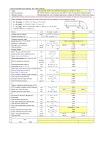To eliminate hazards associated with piping that carries hazardous materials, Standards Australia International (SAI) has released AS 1345-1995 Identification of the contents of pipes, conduits and ducts.
Colour code marking will make identification easier for raw material and fluid that being transport by the pipe. The code does not apply to pipelines buried in the ground. The code cannot be expected to cover every particular industrial requirement and discretion should be used in its application.
Colour Codes :-
The code uses ground colours to indicate the types of fluids carried by the pipelines. It also uses safety colours and lettering to provide additional information.
Colour Code Indications For Pipe works and Valves
- Colours are applied directly to the pipe or, in the case of small pipes, over an area immediately behind the pipe. Or, coloured tags can be used, provided that they are attached securely to the pipe and are clearly visible.
- The ground colour is applied over the full length of the pipeline or over a minimum length of 400 mm, whichever is available.
- When used in conjunction with a safety colour, the ground colour is applied for a minimum length of 150 mm on each side of the safety colour.
- The safety colour is applied for a minimum length of 75 mm where it is clearly visible. The location of identification markings is at intervals of not more than 8 m and preferably adjacent to branches, junctions, valves, etc.
- AS 1345-1995 Identification of the contents of pipes, conduits and ducts should be applied. Requirements laid down in other standards should also be kept in mind.
For example:
● AS 2885.4-2010 Pipelines - Gas and liquid petroleum - Submarine pipeline systems
● AS/NZS 1596:2008 The storage and handling of LP Gas
● AS 4041-2006 Pressure piping
















-page-001.jpg)

0 Comments